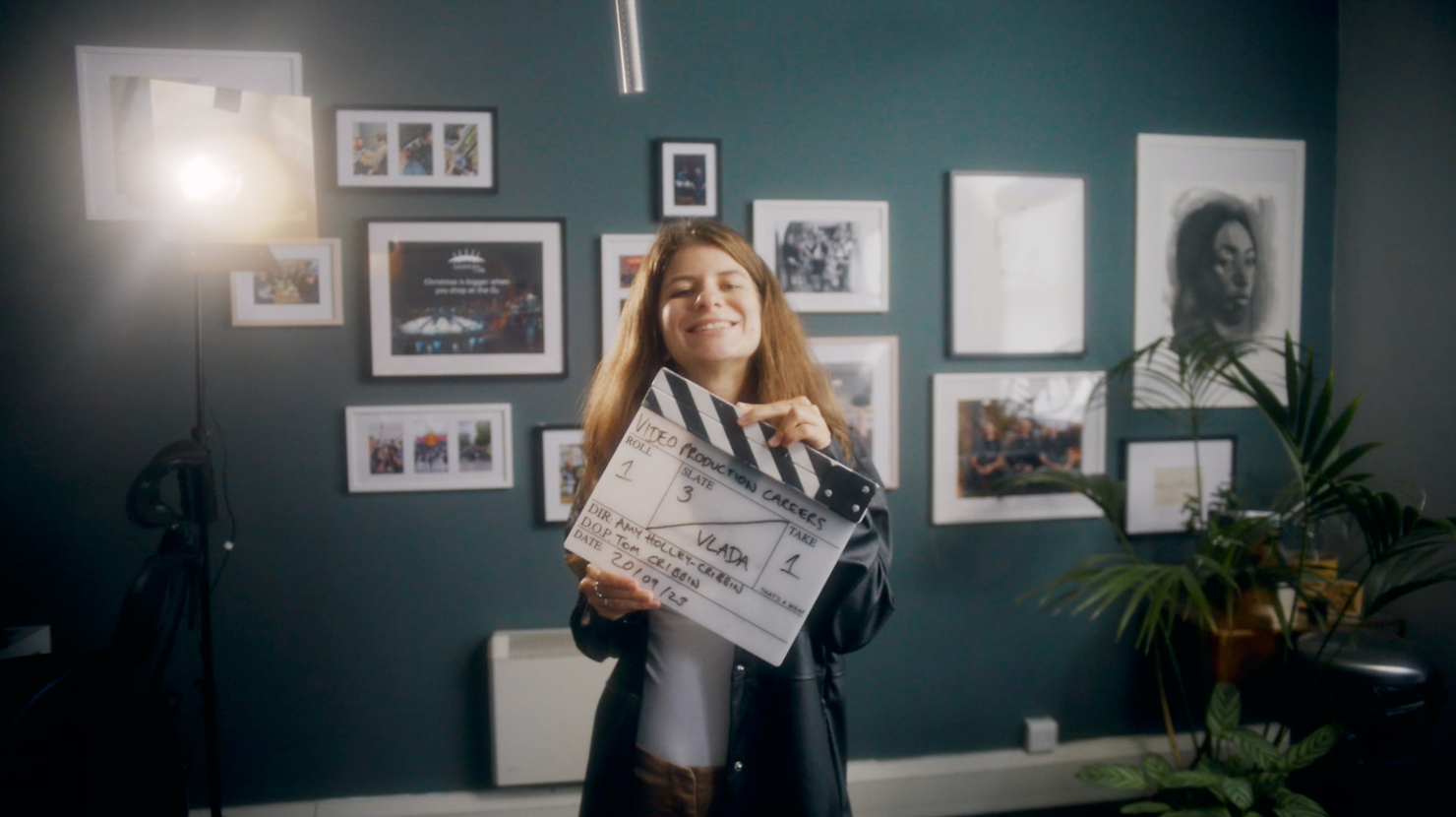For each type of filming space, you need a different checklist to work through to make sure you are ready to shout ‘Rolling!’. When it comes to producing high-quality videos, having the right studio space is crucial. Whether you are shooting a commercial, a music video, a corporate presentation, or any other video content, the studio serves as the canvas upon which your creative vision comes to life.
This blog takes you through the process of building a set in an empty film and photography studio, enabling you to deliver exceptional results that captivate your audience and elevate your brand’s presence. In May 2023, we filmed for longstanding clients Derwent Art. Due to the nature of this shoot (lots of products), we decided it was best to hire Kinetic Studios (see photos below).

Empty studio before Nomadic UK’s set build for a video shoot for Derwent Art
The 1600 square foot photography studio itself is one of the largest and best equipped studios in South West England for commercial photo shoots and it’s shining glory is it’s huge white infinity cove. Nomadic have hired the impressive infinity cove at Kinetic Studios on numerous occasions over the years, so we were very familiar with the space when we received the go ahead to film our next Derwent video there. So where did we begin?
Step 1: Vision and Pre-Production Planning
Before embarking on any studio transformation, it is essential to have a clear vision for your video shoot. Collaborate with your team to brainstorm ideas and outline the creative direction. Determine the specific shots you want to capture, the atmosphere you wish to create, and the overall message you want to convey. This pre-production planning will serve as a roadmap for transforming the studio space to align with your goals effectively.
Step 2: Choosing the Right Space
Once you have a clear idea of what you want to capture, it is then much easier to choose the right space for you. Make sure the studio is large enough to accommodate your needs, which may vary depending on the scale of your project. For example, if you are organising a fashion shoot with multiple models, stylists and hair and makeup artists, you are going to need not only a very large studio space, but also a green room with enough space to get ready and store all the props and outfits. However, for our shoot with Derwent, we were working with an artist and art supplies, so we were only limited in terms of our need for a moderate-sized studio, with comfortable space for our kit, crew, the artist, the artist’s table and their supplies.
If possible, organising a recce can be extremely helpful during pre-production, and can end up saving you both time and money. Assessing the space ahead of the shoot will allow you identify any potential unforeseen issues, such as parking or accessibility problems, or insufficient space and lighting. It is also a good idea to produce a risk assessment as part of this, to ensure working conditions are safe and up to standard. Ideally a recce will be conducted far enough in advance to allow for any of these identified issues to be fixed, or alternate arrangements made. A recce will also give you a good idea of what facilities and kit are available, as some studios have built-in lighting rigs, sound equipment, green screens, etc. Checking our the space ahead of time will also allow you to start to visualise how everything will come together on the day of the shoot.

The beginning of the build at Kinetic Studio, Winchcombe in their infinity cove
Step 3: Studio Layout and Set Design
Optimising the studio layout and set design is pivotal for a successful video shoot. Consider the size of the studio space and plan the layout accordingly. Allocate separate areas for filming, equipment storage, and a dedicated space for the production crew to collaborate and prepare.
Additionally, based on your creative vision, design the sets and props that will bring your narrative to life. Remember that the set design should complement your message while ensuring that it does not clutter the space or hamper the shooting process. If you are filming for a brand with specific brand colours, consider incorporating their colour palette into your design, whether with the backdrop or with props and wardrobe.

Step 4: Lighting and Ambience
Lighting plays a central role in any video production, and the studio environment must offer flexibility in this regard. Lighting alone will completely transform any space, but when shooting in a studio it is vital for making the most out of it. This is why you should check the studio environment as it should offer space, flexibility and potentially even appropriate lighting fixtures (rafters, cables, etc.) on which you can install the gaffer’s kit.
Depending on the type of shoot, you might need to create various lighting setups to achieve different moods and effects. Experiment with lighting angles and intensity to ensure your subject is well-lit and visually appealing on camera. You may also need to try a few different techniques. For example, with our recent shoot for Derwent Pencils, we knew that the paper, walls and floor was going to be white, meaning light was going to be bouncing everywhere which would create a flat image. This is why we needed to introduce negative fill, which absorbs light and creates contrast in our overall image. This meant the pencils, paints and chalks were not lost in the image, leaving it to reveal to fine textures of the equipment.
Step 5: Soundproofing and Acoustics
Audio quality is equally important as video quality in a production shoot. To ensure crystal-clear sound, address soundproofing and acoustics in the studio space. Minimise external noise interference by using soundproofing materials on walls and floors. Additionally, strategically place acoustic panels to reduce echo and improve sound clarity during recording sessions.
Some studios are specially equipped for sound recording, with all of the right fixtures and equipment, and some are equipped purely for visual only. This is a very important aspect to check before the shoot (ideally during your recce), so you can prepare accordingly. For example, if you’re filming 3 actors talking to each other in a studio that isn’t sound proofed, you may have to bring sound blankets to absorb sound wave reflections. If you are shooting an advert that utilises a voiceover and you need to record it that day, you can try and find a quiet corner, with the help of a couple of sound blankets you should be good to go. Alternatively, you can use ADR (Automated Dialogue Replacement), which is where you record dialogue afterwards to be in sync with the video. This is a very common technique used in TV.

Nomadic UK filming Jake Spicer using Derwent’s Inktense XL Blocks
Step 6: Camera and Equipment Setup
A well-equipped studio is the backbone of any successful video shoot. Check and see what equipment is available to hire along with the studio, some studios even offer discounts in conjunction with studio hire. This may allow you access to more premium kit than you already have, so it’s always worth checking. In terms of your kit, it is worth investing in high-quality cameras, lenses, tripods, and other essential equipment needed to capture professional-grade footage. Organise the equipment neatly and ensure that cables and wires are properly managed to avoid any hindrances during filming.
You could also set up a video village, i.e., a viewing area with an external monitor, where the director or client can view what is being captured in real time. This is something we have set up for Derwent on previous shoots, as it helps improve the client experience, and allows them to give input on what is being filmed, ultimately making the edit process smoother.
Step 7: Scheduling and Test Shoots/Rehearsals
Now that you’ve chosen a studio that is right for you and decided on what equipment you require, it’s time to book in your filming date! Ensure you book a day that allows plenty of time for post-production before any deadlines, and consider booking an additional day or two before the filming date for setup and test shoots/rehearsals.
During the test shoot, try different camera angles, lighting setups, and audio configurations to refine the process and see what works best. This stage also allows the production team and talent to get comfortable with the studio environment, ensuring a smoother and more efficient shoot when the cameras start rolling. You can also arrange for the actors/models to come in to make sure the lighting and audio tests are as accurate to the shoot as possible, and also to rehearse any choreography or script that they might need to memorise prior to the shoot.
Conclusion & The Finished Product!
Transforming a studio space for a video production shoot is a multi-faceted process that requires careful planning and attention to detail. By envisioning the final product, designing an appropriate set, optimising lighting and sound, and using high-quality equipment, you create an environment conducive to unleashing creativity and achieving professional results.
With a well-prepared studio space, your video production shoot will not only impress your audience but also solidify your brand’s reputation as a creative and visionary force in the industry. So, embrace the possibilities, plan meticulously, and let your studio space become the backdrop for captivating storytelling and compelling visual experiences.
Check out the final product below!
To work with Nomadic on another incredible shoot in the largest and best equipped studios in South West England, then get in touch to find out how we can help you tell your brand story!
Email us at hello@nomadic.uk, call us on 01242 373942, or pop in to speak to us at Nomadic UK’s HQ, Unit 2, Fairview Court, 119-127 Fairview Road, Cheltenham, Gloucestershire, GL52 2EX. Or fill out the form below.
And don’t forget to check out our latest Instagram post to see where we are and what we are working on this week!



